Tokenisation in online payments: robust protection against data breaches


Dealing with cardholder's data, to say nothing of storing it, places a great responsibility on any organisation. One of the modern types of data protection is tokenisation. It protects sensitive data against losses or thefts. Further, we'll go into the matter of tokenisation and its impact on online payments.
This solution allows for processing payments without exposing sensitive details that could breach security and privacy. Tokenising a cardholder's data during online payments makes it impossible to access sensitive credit card data and adds to overall transaction safety.
There are several ways to generate tokens, but the primary point is that tokens are NOT considered cardholder data.
Format-preserving tokens
In this type, the 16-digit credit card number is replaced with a token of a similar appearance. It includes only numeric characters. Some format-preserving schemes can maintain the card number's first six and last four digits.
Example: Card number: 5111 1111 1111 1111 — Token: 5111 8647 2375 1111
Non-format preserving tokens
This type replaces a credit card number with a token that does not resemble the original. It can include both numeric and alpha characters.
Example: Card number: 5111 1111 1111 1111 — Token: 23c91e14-89f6-417f-9d60-7596a34u0829
So, what's the result? A token restricts the misuse of sensitive information. The algorithm makes the data unable to be traced back to its source.
Utilising this technology in transaction processing makes it difficult to reverse engineer the original data from a token. It eliminates the storage of credit card numbers, helping to improve data security. Moreover, it appears to be very beneficial to merchants, decreasing the impact of expensive security breaches. In a word, tokens are useless for hackers, even if they get access. Customers don't want to risk too. They would prefer their card account number to be tokenised during online payments. This simple process protects them against data and money losses in case of fraud.
This solution takes the security of financial transactions to the highest level and facilitates contactless payment methods (for example, payment via smartphone). The use of token service during online payments brings forth a bundle of benefits:
We at Corefy guarantee that sensitive card data will never affect your servers. We use a secure database consisting of a set of related tables. As a rule, data remains in storage until it's needed to identify a person when paying or doing other related tasks. After the received data fulfils its function, it is returned to the repository or updated for further safe storage.
We recommend this parameter to enhance your protection when creating a payment invoice. It is one of the essential methods for protecting users' confidential data with card transactions.
Token services are widely used in e-commerce today. It enables additional protection for transferring sensitive data and prevents online businesses from data thefts and losses. Replacing sensitive data with tokens also reduces paperwork and participation of third-party agents and saves you additional costs. Contact our team to find out more about our payment orchestration platform and see how it works.